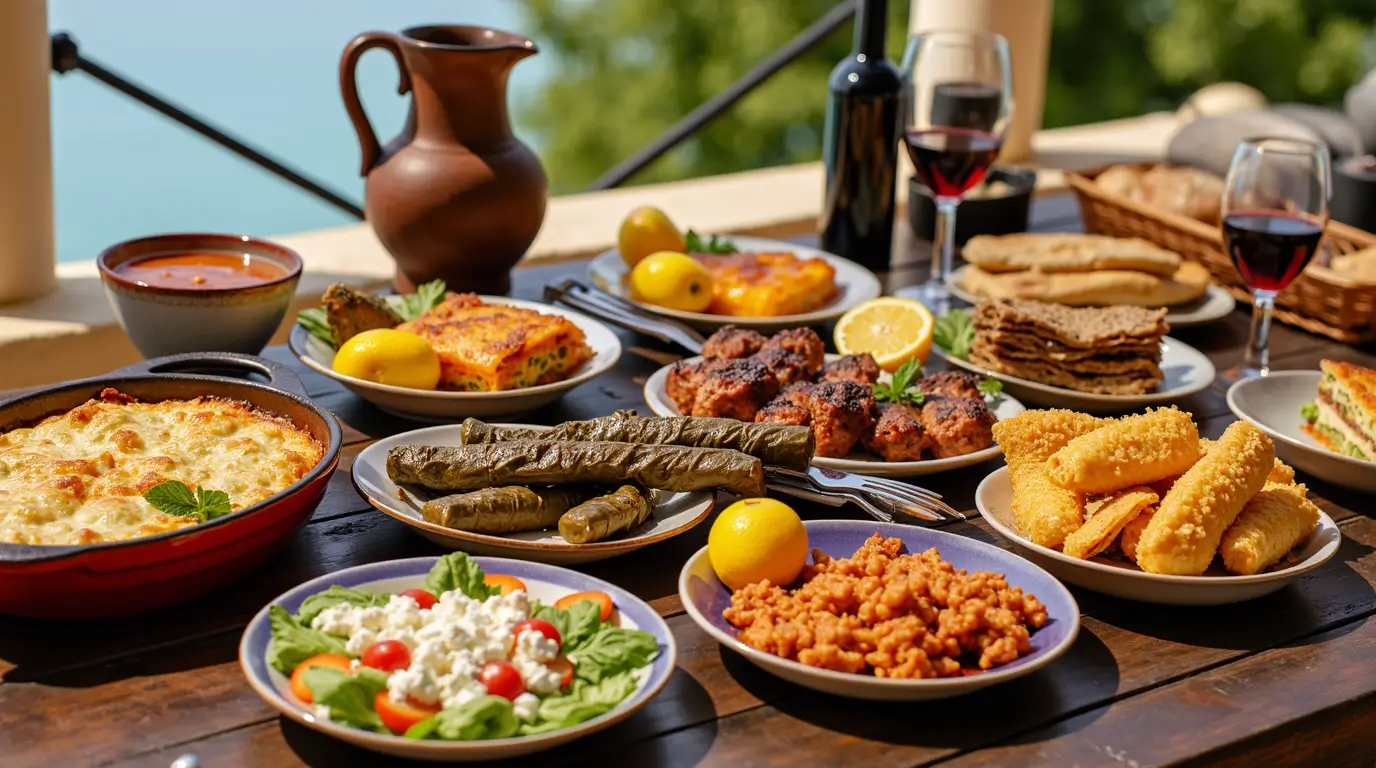Table of Contents
Greek cuisine is renowned worldwide for its vibrant flavors, wholesome ingredients, and strong connection to both history and local culture. With roots that trace back thousands of years, Greek gastronomy has evolved through conquests, trade, migration, and innovation, making it one of the most diverse culinary landscapes in the Mediterranean region. In this comprehensive article, we will delve into the various facets of Greek cuisine, following a structured approach that encompasses history, regional variations, key ingredients, iconic dishes, distinctive flavors, dining customs, modern trends, and more. Whether you have traveled to Greece before or are looking to explore this cuisine for the first time, you will find plenty of reasons here to appreciate and savor the tastes of Greece.
Introduction
Greek cuisine is deeply interwoven with the country’s cultural identity and communal traditions. From the simplest mezé (appetizer) to elaborate festival feasts, food is a focal point of daily life and social gatherings. Eating in Greece is never just about sustenance; it is about celebration, hospitality, conversation, and connection.
Stepping into a traditional taverna, you are likely to witness tables brimming with small plates of olives, cheeses, fresh bread, and dips like tzatziki, while lively banter and laughter fill the air. These warm, communal traditions are reflective of xenia, the Greek concept of hospitality toward guests and strangers alike. It is this sense of warmth and sharing that draws so many visitors to Greek cuisine.
Yet, the story of Greek cuisine is more than just convivial meals and fresh ingredients. It is a story rooted in the country’s rich history—a history that includes the legacy of ancient Greece, periods of Roman and Ottoman rule, interactions with Mediterranean neighbors, and a modern evolution that reflects contemporary global influences. Each period has added new layers of technique, ingredient availability, and inspiration, culminating in a cuisine that is both deeply traditional and dynamically innovative. In the following sections, we will explore these aspects in depth.
Culinary Context and History
Culinary Context and HistoryAncient Beginnings
The roots of Greek cuisine stretch far back in time, with references to food culture appearing in ancient texts such as Homer’s Iliad and Odyssey. Ancient Greeks valued simplicity, yet they also reveled in fine ingredients like honey, olives, and wine. Grains (especially barley) formed the basis of many meals, accompanied by vegetables, fruits, and modest amounts of meat. Fish and seafood were staples in coastal regions, reflecting Greece’s relationship with the sea.
In antiquity, food was often part of social rituals and religious events. Symposiums (drinking parties) showcased not only wine but also an array of dishes meant to encourage conversation, debate, and cultural bonding. Herbs and seasonings like oregano, thyme, garlic, and onion were already integral in flavoring dishes, foreshadowing the Greek preference for aromatic and herbal flavor profiles.
Roman and Byzantine Influences
With the rise of the Roman Empire, Greece became integrated into a broader network of trade routes. Spices and food customs from the eastern Mediterranean seeped into local cooking. Over time, the Christian traditions of the Byzantine Empire further influenced dietary practices—fasting periods such as Lent and various other religious observances played a pivotal role in shaping meal structures and ingredient choices. During these times of fasting, Greeks developed a variety of vegetable and legume-based dishes, forming the foundation of what we now recognize as Greek ladera (vegetable dishes cooked in olive oil).
Ottoman Rule and Levantine Exchanges
A defining period for Greek cuisine was the nearly four centuries of Ottoman rule. This era brought culinary techniques and dishes from the Middle East, North Africa, and beyond. Desserts like baklava and kataifi, dishes such as dolmades (stuffed grape leaves), and influences like the use of phyllo dough were entrenched in Greek cooking through Ottoman influence. Spices like cinnamon, cloves, and cumin also became more common in savory dishes (for example, in ground meat fillings).
In addition to Ottoman culinary legacies, the maritime connections of Greece facilitated exchange with Italy and other Mediterranean regions. Ingredients like tomatoes, peppers, and potatoes, brought over from the New World, were integrated into Greek cooking, eventually becoming mainstays in dishes like fasolada (bean soup) and kokkinisto (red-sauce stews).
Modern Era and Regional Differences
Greece’s modern state emerged in the early 19th century, but regional culinary distinctions remained quite pronounced. While there are certain dishes that appear across the country, each region has its own local interpretations.
- North (Macedonia, Thrace, Epirus): Closer to the Balkans, the north of Greece often features heartier stews and dishes influenced by cooler climates and historical Slavic, Turkish, and Balkan connections. Traditional pies stuffed with greens, cheese, or meat—like spanakopita—are common. Local cheeses, cured meats, and distinct pastries flourish here.
- South (Peloponnese, Attica): Mainland Greece’s south and the area around Athens have a more direct influence from Central Greece and have historically been a crossroads of ancient Greek culture. You’ll find both fish dishes (due to proximity to the Gulf of Corinth and the Aegean Sea) and mountainous recipes for grilled meats. The Peloponnese is known for excellent olive groves and citrus orchards, influencing local cooking with intense olive oil flavors and bright lemon accents.
- East (Aegean Islands, Eastern Aegean, Dodecanese): Island regions boast bountiful fresh fish, seafood, and an array of local cheeses. You’ll find a higher use of capers, sun-dried tomatoes, and local herbs like wild sage, thyme, and oregano grown on rocky hillsides. The eastern islands, once under various powers such as the Venetians and Ottomans, have dishes that combine Greek basics with more pronounced spice blends or specialized pastry techniques.
- West (Ionian Islands): Once influenced by the Venetians, French, and British, the Ionian Islands have a cuisine that is somewhat distinct from the rest of Greece. Pastitsada (a meat and pasta dish with a rich, spiced sauce) is popular in Corfu, for instance, reflecting Venetian influence. There is a noticeable embrace of butter and cream in certain Ionian dishes, distinguishing them from the more commonly olive oil-centric dishes elsewhere.
Key Ingredients and Local Products
Emblematic Foods
- Olive Oil: Arguably the cornerstone of Greek cooking, olive oil is used generously in everything from frying and sautéing to drizzling over salads and fresh bread. Regions like Crete and Kalamata are renowned for their high-quality extra-virgin olive oils.
- Olives: Beyond the oil itself, whole olives—particularly Kalamata olives—are a staple at the Greek table. They appear in everything from stews and salads to savory pies.
- Cheese (Feta and Beyond): Feta, made from sheep’s milk (sometimes blended with goat’s milk), is the star cheese of Greece. Yet other options like graviera (a hard cheese), kasseri (a semi-hard cheese), and mizithra (a fresh whey cheese) also find their way into many dishes.
- Fresh Herbs: Oregano, thyme, rosemary, basil, dill, and parsley are all regularly used. Greek oregano, in particular, is famed for its robust flavor and aromatic quality.
- Legumes: Lentils, chickpeas, fava beans, and giant beans (gigantes) are integral to Greek diets, forming the base of comforting soups, salads, and oven-baked casseroles.
- Vegetables: Eggplants, zucchini, peppers, onions, and tomatoes appear in countless dishes, either baked, stuffed, or stewed. Vegetables often become the centerpiece, especially during fasting periods.
- Meat and Seafood: Lamb, pork, chicken, goat, and beef are used in various dishes, but in moderation compared to some other cuisines. Seafood is essential, given Greece’s extensive coastline. Sardines, anchovies, octopus, calamari, and a variety of fish feature prominently in seaside tavernas.
- Phyllo Dough: A thin, delicate pastry dough used in savory pies (spanakopita, tyropita) and sweet treats (baklava, galaktoboureko).
- Honey: Ancient Greeks revered honey, and its use continues extensively in desserts and sweet pastries.
- Spices: Cinnamon, cloves, allspice, and cumin appear in unexpected places such as meat dishes. These influences date back to Levantine and Ottoman culinary traditions.
Seasonality
Seasonality is fundamental to Greek cuisine. Menus change to reflect what’s fresh in the markets. During spring, wild greens and herbs are abundant, leading to a wide variety of hortópites (greens pies). In summer, tomatoes, cucumbers, and peppers are at their peak, facilitating vibrant salads (like the famous horiatiki). Fall is the season for grape harvests, figs, and the early stages of the olive harvest. Winter sees more hearty stews, soups with legumes, and roasted meats. In every season, Greeks manage to highlight fresh, locally grown produce.
Buying Tips for Recreating Greek Cuisine at Home
- Olive Oil: Look for reputable brands labeled “extra-virgin.” Mediterranean specialty stores often carry higher-quality Greek olive oils. If authenticity is a must, choose products from Crete, Kalamata, or other well-known regions, which are often marked on the label.
- Cheeses: For feta, try to find a version stored in brine, as it retains more flavor. Many Greek or Mediterranean specialty stores in large cities carry various Greek cheeses. If unavailable, a domestic feta of good quality is acceptable.
- Herbs: Dried Greek oregano can be found in specialty stores or online. The difference in aroma compared to ordinary oregano is notable.
- Phyllo Dough: Most grocery stores carry phyllo dough in the freezer section. If possible, choose a Greek brand, as the sheets are often thinner and more elastic, making it easier to work with for Greek pastries.
- Legumes and Specialty Items: Middle Eastern or Greek specialty shops frequently stock giant beans, fava, or cracked wheat for pilafs. They may also have grape leaves for stuffing (dolmades).
- Seafood and Meats: For fresh seafood, look for reputable fishmongers and aim for smaller fish if you want to replicate some taverna favorites. For meats like lamb or goat, you may need a butcher that caters to Mediterranean or Middle Eastern communities.
Must-Try Traditional Dishes
Greek cuisine offers a wide spectrum of dishes that cater to various palates, from hearty and meaty to light and vegetable-driven. Below are some of the most iconic dishes, along with a few simplified recipes.
Moussaka
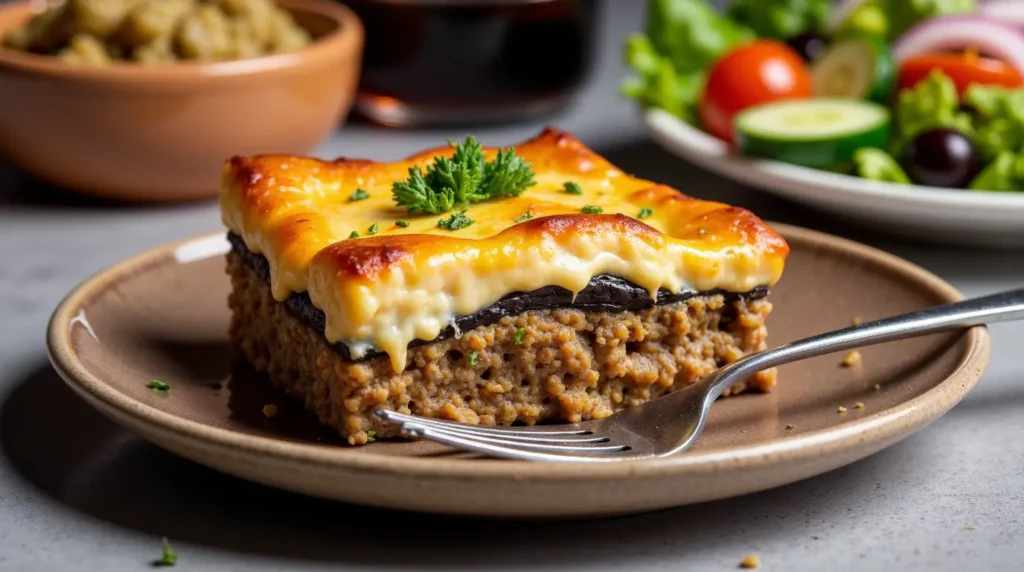
History and Characteristics: Moussaka is often hailed as Greece’s national dish, though versions of it exist throughout the Balkans and the Middle East. The Greek version, however, is distinctive for its layers of fried eggplant, ground meat (usually lamb or beef) cooked with onions, garlic, tomatoes, and warming spices such as cinnamon or allspice, topped with a creamy béchamel sauce, and then baked until golden brown.
Regional Variations: On some islands, moussaka might be made with zucchini instead of eggplant or incorporate local cheeses. In more health-conscious, modern twists, the eggplant is often grilled or baked instead of being fried.
Simplified Recipe (Serves 6):
- Ingredients
- 2–3 large eggplants, sliced into ¼-inch rounds
- 1 lb (450 g) ground lamb or beef
- 1 onion, finely chopped
- 2 cloves garlic, minced
- 1 cup tomato purée (or crushed tomatoes)
- 1 teaspoon ground cinnamon
- Salt and pepper to taste
- 3 tablespoons olive oil (plus extra for brushing eggplants)
- 2 tablespoons flour
- 2 cups milk (whole milk works best)
- 2 tablespoons butter
- A pinch of nutmeg
- 1 egg (optional, for thickening béchamel)
- Instructions
- Preheat oven to 400°F (200°C). Brush eggplant slices with olive oil, season with salt, and bake until lightly browned (about 15–20 minutes). Alternatively, grill them on a stovetop grill pan.
- In a skillet, sauté the chopped onion in 3 tablespoons of olive oil until translucent. Add minced garlic and ground meat, cooking until browned. Add tomato purée, cinnamon, salt, and pepper. Simmer for 10–15 minutes.
- For the béchamel, melt butter in a saucepan over medium heat, whisk in flour, and cook for a minute. Gradually whisk in milk, stirring until it thickens. Season with salt, pepper, and nutmeg. If desired, whisk in one beaten egg for an even richer sauce.
- Layer half the eggplant slices in a baking dish, then spread the meat sauce. Top with the remaining eggplant, and pour the béchamel sauce over the top.
- Bake for about 30–40 minutes or until the béchamel is golden. Allow to cool slightly before serving.
Spanakopita (Spinach Pie)

History and Characteristics: Spanakopita is a beloved Greek savory pie made with fresh spinach, herbs, and feta cheese, all enveloped in crispy layers of phyllo dough. Its origins trace back to ancient times, when similar pies used wild greens and herbs. Over centuries, regional variations have flourished, some adding leeks or dill, others mixing various greens.
Simplified Instructions:
- Sauté spinach with onions, garlic, and herbs like dill or parsley.
- Mix in crumbled feta cheese and let the mixture cool.
- Layer sheets of phyllo dough in a baking dish, brushing each layer with olive oil. Place the spinach-feta mixture in the middle, then top with more layers of phyllo.
- Bake until the phyllo is golden and crispy.
Dolmades (Stuffed Grape Leaves)
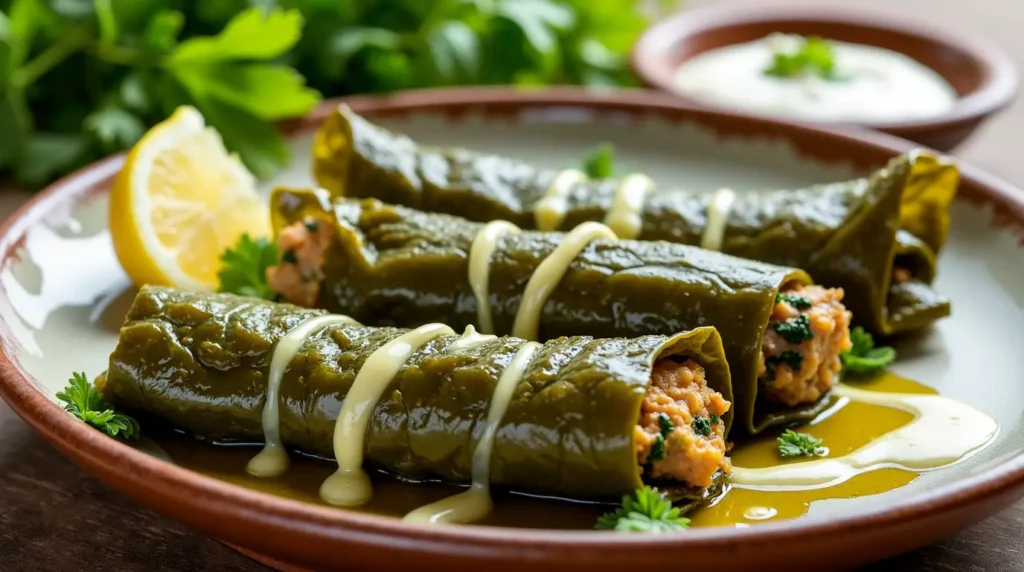
History and Characteristics: Dolmades are grape leaves stuffed with a rice-and-herb mixture (sometimes including ground meat). They are emblematic of Ottoman influence and a staple in Greek households and tavernas.
Regional Variations: In Northern Greece, meat versions are more common, whereas in the islands, vegetarian dolmades might include pine nuts and raisins. They can be served warm with avgolemono sauce (egg-lemon sauce) or at room temperature with lemon wedges.
Souvlaki and Gyros
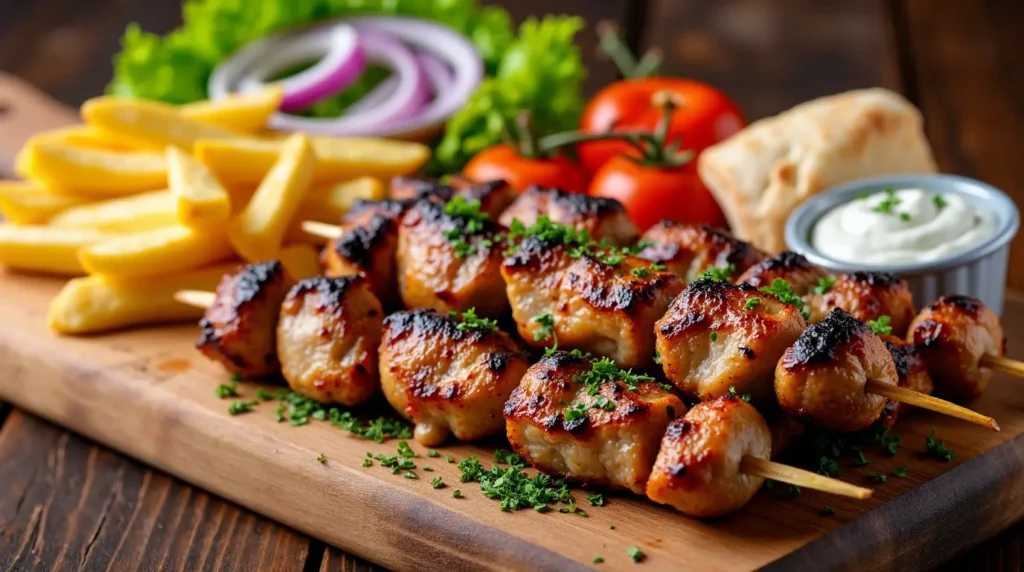
History and Characteristics: Souvlaki consists of grilled skewered meat (usually pork or chicken, though lamb is also popular in some regions) marinated in olive oil, lemon juice, oregano, and garlic. Gyros, on the other hand, is made from stacked slices of marinated meat cooked on a vertical rotisserie. These are Greece’s best-known street foods, often served in pita bread with tomatoes, onions, tzatziki, and fries.
Pastitsio
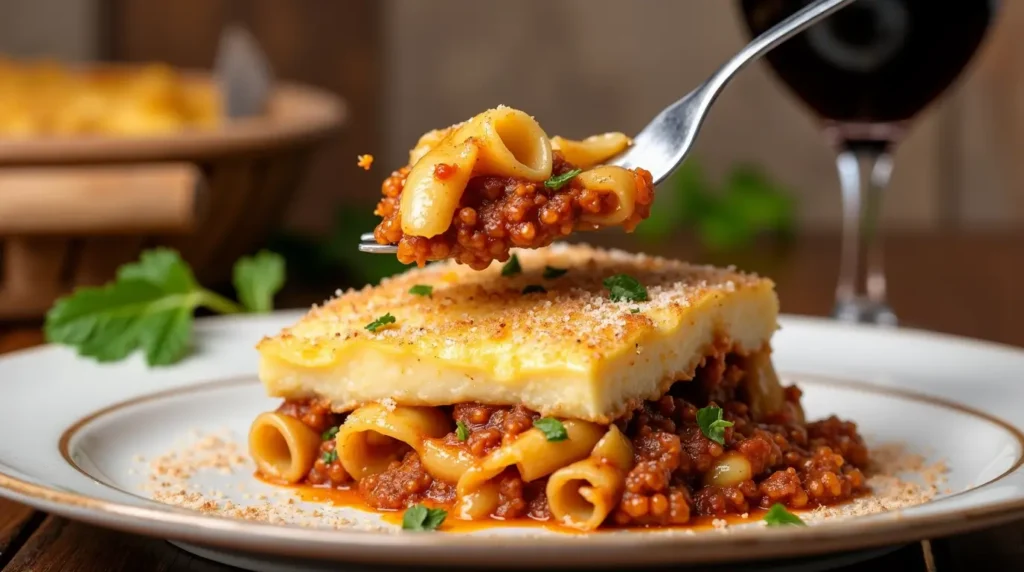
History and Characteristics: Often described as Greek lasagna, pastitsio layers tubular pasta, a fragrant ground meat sauce, and a thick béchamel topping. The dish is baked, resulting in a creamy, comforting slice of layered goodness. The use of cinnamon or nutmeg in the meat sauce underscores Greek cuisine’s love of warm spices in savory dishes.
Greek Salad (Horiatiki)

History and Characteristics: The classic Greek salad is a celebration of summer produce: tomatoes, cucumbers, green bell peppers, onions, olives, and a generous slab of feta cheese. Dressed simply with olive oil, oregano, and sometimes vinegar, its straightforwardness highlights fresh flavors. Variations might include capers or rusks, especially in Crete.
Other Notable Mentions
- Tzatziki: A tangy yogurt, cucumber, and garlic dip.
- Fasolada: A nourishing bean soup often deemed Greece’s “national dish.”
- Baklava: Layers of phyllo, nuts, and honey syrup, emblematic of sweet Greek treats.
- Galaktoboureko: A semolina custard baked in phyllo dough, soaked in syrup.
- Loukoumades: Bite-sized doughnuts drizzled with honey and sprinkled with cinnamon.
Defining Characteristics of Greek Cuisine
Greek cuisine is often praised for its balance of flavors, reliance on fresh, high-quality ingredients, and a preference for simple yet effective preparation methods. Here are some key descriptors:
- Aromatically Herbal: The generous use of oregano, dill, parsley, thyme, and rosemary lends a fragrant quality to many dishes.
- Mild to Moderately Spiced: Although warm spices like cinnamon and cloves appear in savory contexts, Greek dishes are generally not spicy-hot. Instead, the emphasis is on enhancing natural flavors through herbs, lemon, and olive oil.
- Healthy and Olive Oil-Centric: Because of the Mediterranean climate and culinary traditions, salads and vegetable-based dishes are paramount. Olive oil is at the heart of most recipes, contributing to the perception (and reality) of Greek food as healthy and heart-friendly.
- Flavor Combinations: Common pairings include lemon-oregano, feta-olive oil, tomato-cinnamon, and yogurt-honey. These pairings are distinctively Greek and create memorable taste profiles.
- Appeal to Food Enthusiasts: Food lovers who appreciate fresh, seasonal ingredients, robust herbal notes, and a balance of meat and vegetable dishes will find Greek cuisine alluring. Its mixture of ancient tradition and Mediterranean influences makes it familiar yet exciting.
Tips and Highlights to Encourage People to Try Greek Cuisine
- Cultural Connection: Greek food is embedded in millennia of history and mythology. Sampling a dish like moussaka is not merely a culinary experience; it’s a way to connect with ancient and modern stories of Greece.
- Hospitality and Atmosphere: Greek meals often become extended social events, accompanied by music, conversation, and laughter. This communal aspect is something many people find deeply satisfying.
- Versatility and Variety: With everything from meat-based classics to vegetarian and vegan specialties, Greek cuisine can cater to a wide variety of dietary preferences.
- Memorable Flavors: The interplay of lemon juice, oregano, olive oil, and garlic is both comforting and unique. Sweet confections layered with honey and nuts create a strong finishing note.
- Travel Inspiration: Many travelers fall in love with Greek cuisine while visiting Greece’s stunning beaches, historic ruins, or mountainous villages. Even if you haven’t traveled there yet, cooking Greek food at home can serve as a tempting introduction.
Table Rituals and Customs
Typical Meals Throughout the Day
- Breakfast (Proino): Traditional Greek breakfast might include bread or rusks with butter and honey or cheese, olives, and coffee. In modern times, people might grab a koulouri (a sesame-covered bread ring) or a flaky cheese pie (tyropita) on their way to work.
- Lunch (Mesimeriano): Historically, lunch was the main meal. Families often gather around midday for a warm meal featuring vegetables, legumes, or meat dishes with salad and bread on the side. However, modern work schedules sometimes shift the main meal to evening for many urban dwellers.
- Dinner (Vradino): Dinner can be a leisurely affair, especially when dining out at a taverna. It is common to order a spread of mezé (small plates) such as tzatziki, dolmades, and fried zucchini, followed by a shared main dish. Bread, wine, and a salad often complete the table.
- Snacking Culture: Greeks love mid-morning and mid-afternoon snacks, often involving savory pies or sweet pastries. Coffee (particularly Greek coffee or the famous frappe) is enjoyed throughout the day, frequently accompanied by a small cookie or biscuit.
Table Etiquette and Customs
- Sharing Plates: Greek dining is inherently communal. Many restaurants will serve main dishes meant to be shared among the group, each person helping themselves from a central platter.
- Wine and Toasts: Local wines like retsina or varieties from the Peloponnese and the islands might accompany dinner. A common toast is “Yamas!” meaning “to our health.”
- Gestures to Avoid: Directly pointing at someone with a fork or open hand can be seen as disrespectful. Also, the “hand extended with palm out” gesture is offensive in Greek culture.
- Hospitality: If invited to a Greek home, expect a warm welcome and an abundance of food. Refusing an offered dish or second helping might be taken as a sign of disinterest in the host’s hospitality.
National Holidays and Family Celebrations
- Greek Easter (Pascha): The biggest religious holiday in Greece. The Easter Sunday meal often features roasted lamb or goat on a spit, accompanied by red-dyed eggs, tsoureki (sweet bread), and magiritsa (a soup made from lamb offal).
- Name Days and Saint’s Days: Many Greeks celebrate their “Name Day” more elaborately than their birthdays. These celebrations usually involve homemade sweets or pastries offered to guests.
- Christmas and New Year’s: Christmas sees dishes like stuffed turkey or pork, and sweet treats like melomakarona (honey cookies) and kourabiedes (almond cookies dusted with powdered sugar). For New Year’s, the vasilopita (a cake containing a hidden coin) is cut at midnight for good luck.
Modern Trends and Culinary Fusions
Embracing Global Influences
Over the last few decades, Greek cuisine has not remained static. Global culinary trends, the Greek diaspora, and an increase in tourism have all spurred adaptation. Some innovative Greek restaurants combine traditional Greek flavors (like feta, phyllo, and lamb) with techniques from French or Asian cuisines. These fusion dishes maintain Greek gastronomy’s essence while introducing novel presentations or combinations.
New Consumption Trends
- Vegetarian and Vegan Options: With the rise of plant-based eating worldwide, many Greeks are rediscovering the wealth of naturally vegan dishes in their own culinary tradition. Ladera (oil-based vegetable dishes like briám and fasolakia) fit perfectly into such diets.
- Farm-to-Table and Organic: Younger chefs and restaurateurs are reviving local varietals of produce and heirloom grains (like Zea wheat) in an effort to promote biodiversity and sustainability. This “farm-to-table” movement is strong in regions like Crete, where small-scale organic farms provide fresh produce directly to local tavernas.
- Artisanal Food Products: From craft feta to small-batch olive oils, artisanal producers are focusing on quality, traceability, and the revival of ancient methods. These products are increasingly found in specialized shops, not only in Greece but also internationally.
Rising Chefs and Culinary Reinterpretations
In Athens and other big cities, there is a wave of talented chefs redefining Greek cuisine. They employ modern culinary techniques—like sous vide or molecular gastronomy—without abandoning Greek flavors. For instance, a chef might serve a deconstructed Greek salad, presenting tomatoes, olives, and feta in unexpected textures while preserving the quintessential taste. Gourmet versions of street foods like souvlaki or gyros have also become popular, focusing on premium meats and artisanal pita bread.
Conclusion and Call to Action
Greek cuisine is a harmonious blend of ancient heritage, regional diversity, and modern innovation. Its flavors range from fresh and herbal to subtly spiced and sweet, reflecting the crossroads of civilizations that have influenced Greece for centuries. Whether you are drawn to classic dishes like moussaka and spanakopita or curious about contemporary fusion twists in Athens, there is something in Greek cooking for every palate.
To recap, we have explored:
- Culinary Context and History: How ancient Greek, Roman, Byzantine, and Ottoman influences have shaped today’s Greek gastronomy.
- Key Ingredients and Local Products: The significance of olive oil, cheeses, herbs, legumes, vegetables, and more.
- Must-Try Traditional Dishes: Iconic flavors and simplified recipes for favorites like moussaka, spanakopita, and more.
- Defining Characteristics: The herbal, lightly spiced, and olive-oil-forward nature of Greek cuisine.
- Tips and Highlights: Cultural anecdotes and reasons to explore Greek gastronomy.
- Table Rituals and Customs: Insights into meal structures, etiquette, and holiday celebrations.
- Modern Trends and Fusions: How young chefs and global influences are reshaping Greek culinary traditions.

